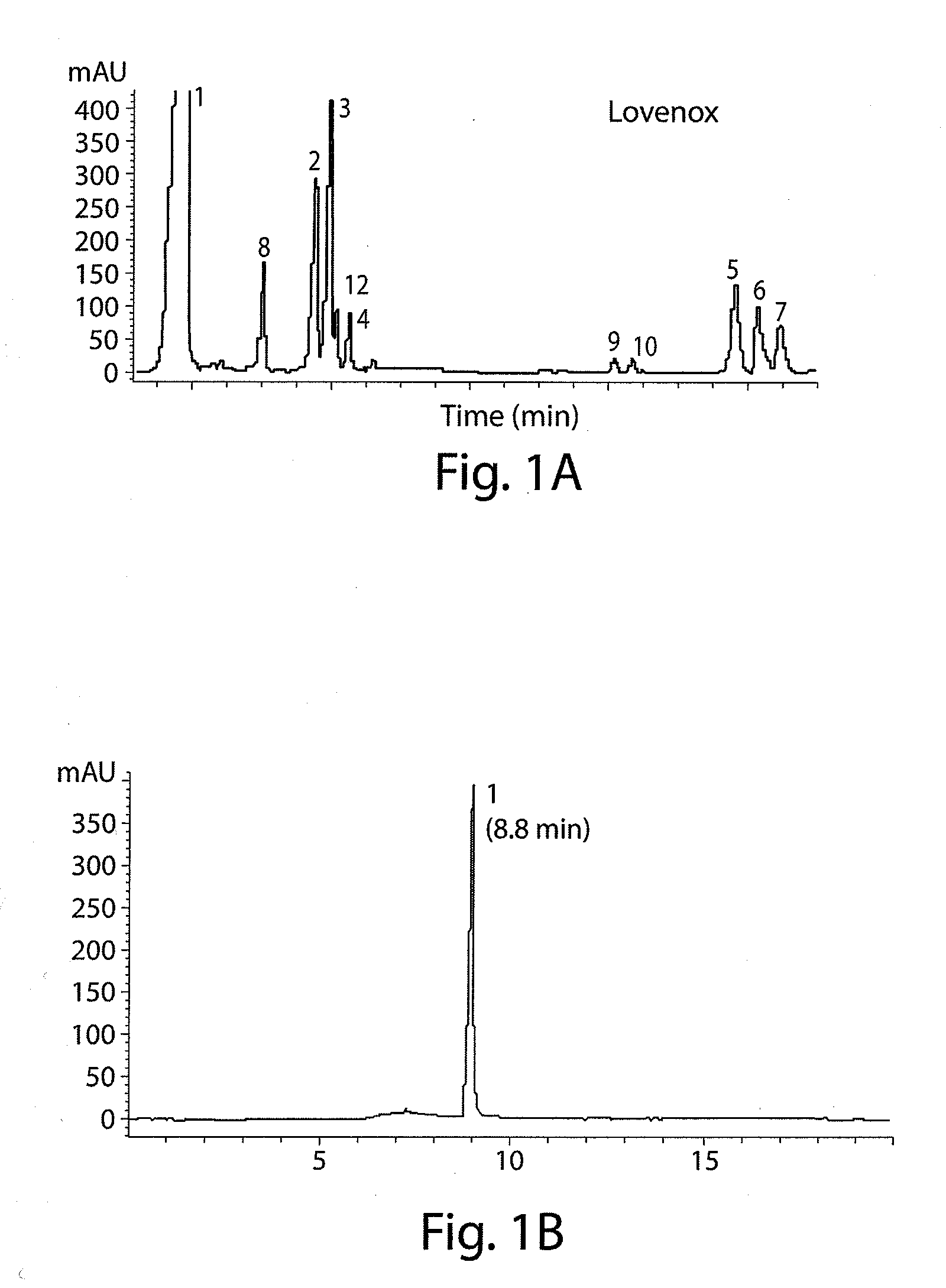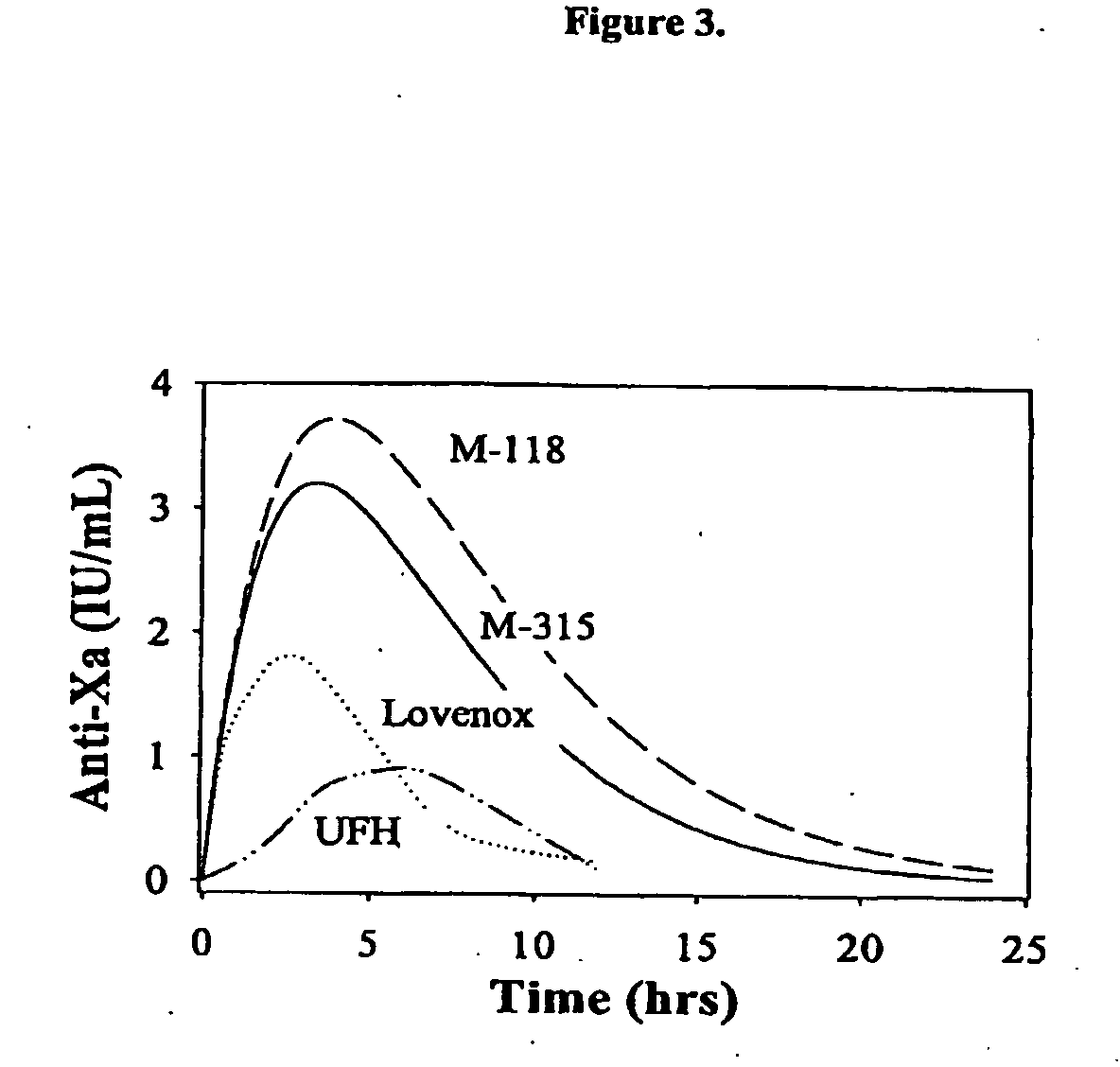Analysis of sulfated polysaccharides
a polysaccharide and heterogeneous technology, applied in the field of analysis of sulfated polysaccharides, can solve the problems of high degree of complexity of hlgags, many risks in the pathway, and high degree of hlgags complexity, etc., to achieve reduced side effects, attractive pharmacokinetics, and reduced binding of pf4
- Summary
- Abstract
- Description
- Claims
- Application Information
AI Technical Summary
Benefits of technology
Problems solved by technology
Method used
Image
Examples
example 1
Development of a Compositional Analysis Method for the Structural Characterization of Heparins
[0240]Several techniques have been utilized for the structural analysis of heparin preparations. Gradient polyacrylamide gel electrophoresis (PAGE) and strong ion exchange HPLC (SAX) have previously been used for the qualitative and quantitative analysis of heparin preparations (Liu et al., Glycobiology 5:765-774, 1995; Turnbull et al., Proc. Natl. Acad. Sci. USA 96: 2698-2703, 1999; Merry et al., J. Biol. Chem. 274: 18455-18462, 1999). The gradient PAGE method, while useful in determining molecular weight, cannot offer information about the fine structure of heparin preparations. SAX-HPLC, relying on detection by ultraviolet absorbance or radioactivity, is often insufficiently sensitive for the detection of small amounts of structurally important heparin-derived oligosaccharides.
[0241]Capillary electrophoresis (CE) is a very sensitive methodology with high resolving power that has been use...
example 2
M115 and M411 are Superior to Other Heparins in Both IIa and Xa Pharmacokinetics after s.c. Administration
[0258]M115 and M411 have markedly increased in vitro anti-Xa and IIa activity, expressed as IU per mg, compared to UFH or other LMWHs. A series of pharmacokinetic experiments using male New Zealand rabbits confirmed this in vivo. In these experiments, either UFH or LMWHs (M115 and M411) were administered to rabbits by subcutaneous injection. Then pharmacokinetic parameters were determined by following either the anti-Xa or IIa activities.
Methods
[0259]Male New Zealand rabbits weighing 2.5 to 3.0 kg were used for pharmacokinetics studies. After anesthesia with Ketamine (40 mg / kg) and Xyalazine (5 mg / kg), a 24-gauze Teflon catheter was inserted into to the center auricular artery. The catheter was connected to a heparin cap filled with isotonic saline. Heparin solutions were injected subcutaneously to the rabbits at 1 and 3 and 6 mg / kg. Four different heparins (UFH, Ardeparin, Enox...
example 3
M115 and M411 are a More Potent Inhibitor of Arterial Thrombosis
[0263]The formation of arterial thromboses is largely due to the activation and aggregation of platelets. Activated thrombin (IIa) is known to be a potent activator of platelet aggregation, hence, molecules containing high anti-IIa activity should be more potent inhibitors of arterial thrombosis formation. We investigated whether or not M115 and M411 produced a more pronounced antithrombotic effect using a rat arterial thrombosis model.
Methods
[0264]The arterial thrombosis model was performed essentially as described with minor modification. Male Sprague-Dawley rats weighing 350-400 g were anesthetized with Ketamine (80 mg / kg) and Xylazine (10 mg / kg). The right side carotid artery was carefully isolated free of surrounding tissues (about 2 cm). A perivascular probe connected to an ultrasonic flow meter (Transonic Flow Meter, NY) was placed under and surrounding the carotid artery to monitor the blood flow rate. The exper...
PUM
| Property | Measurement | Unit |
|---|---|---|
| polydispersity | aaaaa | aaaaa |
| polydispersity | aaaaa | aaaaa |
| time | aaaaa | aaaaa |
Abstract
Description
Claims
Application Information
 Login to View More
Login to View More - R&D
- Intellectual Property
- Life Sciences
- Materials
- Tech Scout
- Unparalleled Data Quality
- Higher Quality Content
- 60% Fewer Hallucinations
Browse by: Latest US Patents, China's latest patents, Technical Efficacy Thesaurus, Application Domain, Technology Topic, Popular Technical Reports.
© 2025 PatSnap. All rights reserved.Legal|Privacy policy|Modern Slavery Act Transparency Statement|Sitemap|About US| Contact US: help@patsnap.com



